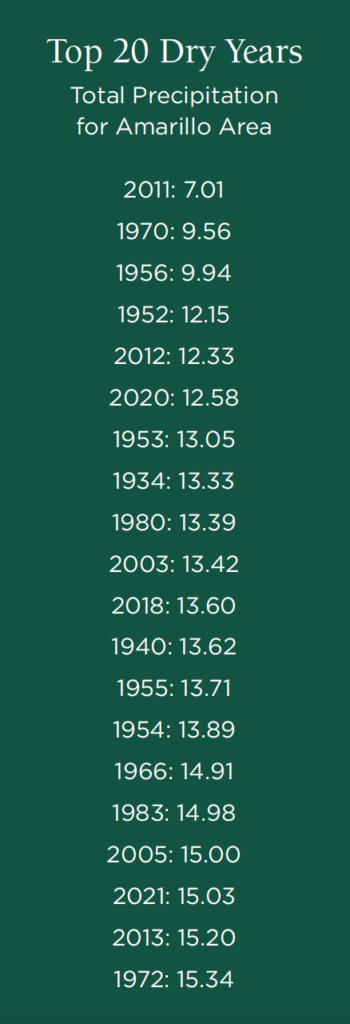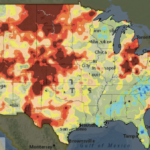Featured image: Dust Storm over the Texas Tech Dairy Barn in the 1920s.
Perhaps more than any event in ranching, drought is the most devastating. Ranchers rely on grass to feed their cattle and rain to grow their grass.
Historically, the Dust Bowl garners the most attention in terms of catastrophic drought. The period from 1934 to 1940 did see repeated below-average precipitation totals. In 2014, NASA released a study naming the 1934 drought the worst in 1,000 years (between 1000 and 2005).
 What made 1934 so bad was it extended across almost 72 percent of western North America. The drought of 2012 was 60 percent. A researcher named Ben Cook from NASA’s Goddard Institute for Space Studies was the lead author on the study and cited a high-pressure system sat over the West coast of the U.S., preventing any wet weather from entering—not dissimilar to what happened in 2013-2014.
What made 1934 so bad was it extended across almost 72 percent of western North America. The drought of 2012 was 60 percent. A researcher named Ben Cook from NASA’s Goddard Institute for Space Studies was the lead author on the study and cited a high-pressure system sat over the West coast of the U.S., preventing any wet weather from entering—not dissimilar to what happened in 2013-2014.
Using the National Weather Service’s online weather data tools, users can see just how much rain fell in a region in a particular region and a particular month. Meanwhile, the National Integrated Drought Information System offers a historical drought conditions map and graph for users to see trends as well as where and how extensive the drought conditions were at any given time.
To parse out all this data, we narrowed our search to the Oklahoma and Texas Panhandle area. The average precipitation for this area from 1934-2021 was 19.65 inches. This was the epicenter of the Dust Bowl as well as geographically central to much of the drought-prone Southwest. Other areas experienced drought conditions of varying degrees at various times, but this area will serve as the model in this examination.
Even with the assistance of all the current resources, measuring drought contains nuance. Ranchers know that one year of drought is difficult, but it’s the year-upon-year drought that is devastating.
During the Dust Bowl years, 1934-1940, the average precipitation was 17 inches. In 1934 and 1940 there were only 13 inches.
The worst year on record was 2011, which only saw 7 inches of precipitation. The next three years were 12, 15 and 19, making the four-year average between 2011-2014 just 13.5 inches.
The worst 5-year drought on record was 1952-1956 with only 12.5 inches on average.
In terms of precipitation, these three timeframes are quite similar. The natural question, then, is why were actual conditions so much worse in the 1930s versus the early 2010s?
- Nationwide drought monitor, 1934.
- Nationwide drought monitor, 1956.
- Nationwide drought monitor, 2011.
The answer comes down to lessons learned from the 1930s, and, of course, improved technology, mobility for ag resources, and governmental policy changes. In the 1930s, agriculturalists were still figuring out which land was best suited for rangeland grazing and which was best for farming. Largely, those determinations have been made in our current day and fragile, drought-prone land is less often farmed. Other farming techniques such as no-till farming and cover crops have helped hold soil as well.
More on the cattle side, the incredible mobility of ag resources has mitigated drought. In the early 2010s, thousands of cattle were shipped from Texas, Oklahoma, and parts of Kansas and Colorado to Wyoming, Montana, the Dakotas and even states like Michigan and Missouri. Likewise, feed from states experiencing surplus could be shipped to droughted-out areas. This almost instant mitigation of the effects of drought was not available in the Dust Bowl days.
Finally, governmental policy has assisted as well. From setting aside certain areas from farming or grazing to developing cost-sharing improvement programs for ranchers to offering crop and rangeland insurance in times of great drought, governmental subsidies have inarguably saved soil degradation.
Despite similar—and in some ways even worse—conditions than occurred in the Dust Bowl, modern agriculturalists have become better stewards of their land and thus avoided some of the catastrophe of our ancestors.
There is one timeless and unchanging aspect to drought, however, and that’s the foreboding doom of day after day of no rain. While today’s ranchers can deal with the circumstances better, the realities of making a living from the land can never be completely mitigated. ★

This article appears in the Fall 2022 issue of the Ranch Record. Would you like to read more stories about NRHC and ranching life? When you become a member of the Ranching Heritage Association, you’ll receive the award-winning Ranch Record magazine and more while supporting the legacy and preservation of our ranching heritage. Become a member today.





